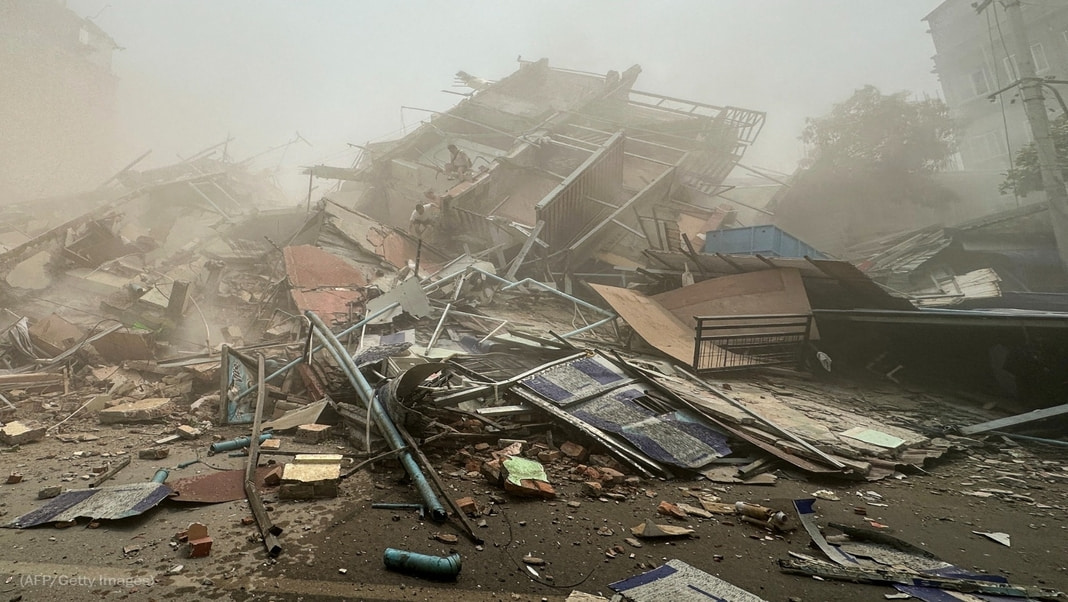Guwahati, March 30: The devastating 7.7 magnitude earthquake that struck Myanmar early Friday has left a trail of destruction, with the United States Geological Survey (USGS) warning that the death toll could climb to 10,000. Rescue teams are scrambling to reach affected areas as aftershocks continue to rattle the region.
Reports say the death toll from Myanmar’s devastating 7.7-magnitude earthquake has risen to over 1,600 on Saturday, with more than 3,400 injured. The agency has issued a Red Alert. Junta chief Min Aung Hlaing has made a rare appeal for international aid, reflecting the crisis’s dire impact.
Myanmar lies on the boundary between two tectonic plates and is one of the world’s most seismically active countries, although large and destructive earthquakes have been relatively rare in the Sagaing region.
“The plate boundary between the India Plate and Eurasia Plate runs approximately north-south, cutting through the middle of the country,” said Joanna Faure Walker, a professor and earthquake expert at University College London.
She said the plates move past each other horizontally at different speeds. While this causes “strike slip” quakes that are normally less powerful than those seen in “subduction zones” like Sumatra, where one plate slides under another, they can still reach magnitudes of 7 to 8.
But what is more worrying is the economic loss. The USGS says the economic loss could be greater than the GDP of the country. “ High casualties and extensive damage are probable, and the disaster is likely widespread. Past red alerts have required national or international response,” the agency said.
According to USGS and the Geological Society of Myanmar, the current earthquake is one of the deadliest to hit Myanmar in recent decades. In 1988, a magnitude 7.0 quake in the region killed 730 people. Given the intensity and population exposure this time, experts fear the death toll could be significantly higher. Landslides triggered by the quake have already been reported in hilly areas, hampering rescue efforts.
Preliminary reports suggest that the worst-hit areas include Mandalay, Taungoo, Kyaukse, Yamethin, Pyinmana, and Sagaing, where strong shaking caused widespread structural collapses. UN Ambassador U Kyaw Moe Tun has called for global aid. “Don’t let this crisis be ignored”, he said.
“Overall, the population in this region resides in structures that are vulnerable to earthquake shaking, though resistant structures exist. The predominant vulnerable building types are informal (metal, timber, etc.) and unreinforced brick masonry construction,” the USGS said.
According to ICRC head of delegation in Myanmar, 24 hours on, parts of Sagaing, Mandalay and Naypidaw are amongst the worst affected. People are still outside in the streets, fearing aftershocks. Electricity and communication networks are down in some places.
Geologist Jess Phoenix told CNN that the region may continue to face tremors and aftershocks in the coming months.
“The force that a quake like this releases is about 334 atomic bombs,” she said.
Emergency response teams, including military personnel and aid workers, are conducting search-and-rescue operations in the most affected areas. The government has appealed for international assistance, with neighboring countries and humanitarian organizations mobilizing aid shipments and disaster response teams. Reports say the scale of devastation and damaged infrastructure pose major challenges to reaching remote communities.

In response to the devastating earthquake that struck Myanmar on Friday, the Indian Army has swiftly deployed a specialised medical task force under ‘Operation Brahma’, according to a statement from the Ministry of Defence. A 118-member team from the Shatrujeet Brigade Medical Responders, led by Lieutenant Colonel Jagneet Gill, is en route to Myanmar with essential medical supplies and equipment.
Prime Minister Narendra Modi spoke with Senior General H.E. Min Aung Hlaing of Myanmar and conveyed deep condolences at the loss of lives in the devastating earthquake. “As a close friend and neighbour, India stands in solidarity with the people of Myanmar in this difficult hour. Disaster relief material, humanitarian assistance, and search & rescue teams are being expeditiously dispatched to the affected areas as part of Operation Brahma,” Modi said on X.
The Association of Southeast Asian Nations (ASEAN) says it recognises the “urgent need” for humanitarian assistance and stands ready to support relief and recovery efforts in quake-hit Myanmar and Thailand.
The regional bloc stands ready to deploy the ASEAN-Emergency Response and Assessment Team, use its disaster emergency logistics system and offer urban search and rescue support, ASEAN foreign ministers said in a statement on Saturday.
Also Read: Nagaland’s rail connectivity boost: CRS approves train operations on Shokhuvi-Molvom route
Also Watch
Find latest news from every corner of Northeast India at hubnetwork.in, your online source for breaking news, video coverage.
Also, Follow us on-
Twitter-twitter.com/nemediahub
Youtube channel- www.youtube.com/@NortheastMediaHub2020
Instagram- www.instagram.com/ne_media_hub
Download our app from playstore – Northeast Media Hub





